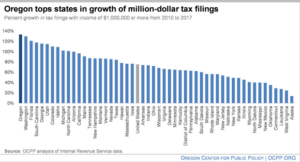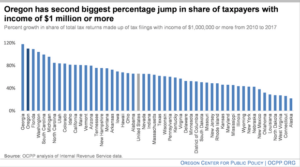The number of taxpayers reporting annual income of $1 million or more has risen faster in Oregon than any other state, according to the Oregon Center for Public Policy’s analysis of newly released data from the Internal Revenue Service (IRS).
From 2010 to 2017, the number of Oregonians with at least $1 million in annual income jumped 133 percent, the Center said. Meanwhile, growth nationally averaged 75 percent.

“This new IRS data strengthens the case for raising taxes on the rich to fund public services that benefit all Oregonians,” said Center communications director Juan Carlos Ordóñez. “It adds to the growing body of research showing that tax rates matter little, if at all, on where rich people decide to live.”
In 2010, the starting point of the data made available by the IRS, Oregon put in place higher tax rates on high-income earners. In January of that year, voters approved Measure 66, one of two successful tax measures on the ballot. Measure 66 raised Oregon’s top marginal tax rate from 9 to 11 percent for couples (joint tax filers) with income above $500,000 a year. The measure also raised the tax rate to 10.8 percent for couples with income between $250,000 and $500,000. In 2012, those rates came down to the current level of 9.9 percent — still higher than before Measure 66.
The IRS data showed not only that Oregon outpaced the nation in growth of the total number of taxpayers with at least $1 million in income, but also in the size of this very high-income group relative to the rest of the state’s taxpayers. “Examining the data this way takes into account differences in population growth among the states,” Ordóñez explained.

The Center found that Oregonians reporting at least $1 million in income made up about 0.1 percent of all Oregon taxpayers in 2010. By 2017, that share had grown to 0.22 percent of all Oregon tax filers. That amounts to a 110 percent growth in the share of tax filers with top incomes — a figure eclipsed by only one state, Georgia.
“At the same time that we’ve seen sharp growth in the number of million-dollar incomes in Oregon, we’ve also seen a housing crisis explode, college tuition climb, and preschool stay out of reach for half of all children in our state,” said Ordóñez. “On many levels, it makes sense to ask the richest Oregonians to contribute more toward the common good.”
The Oregon Center for Public Policy (www.www.ocpp.org) is a non-partisan, non-profit institute that does in-depth research and analysis on budget, tax, and economic issues. The Center’s goal is to improve decision making and generate more opportunities for all Oregonians.





